Visualizing Eigenvalues
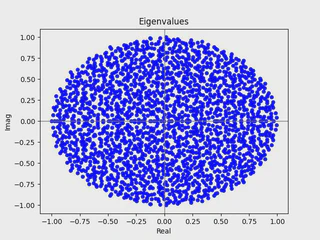 An example of the eigenvalue visualizer.
An example of the eigenvalue visualizer.Visualizing Eigenvalues
This blog post covers an eigenvalue visualizer I created to teach linear algebra.
The goal of the visualizer is to give an interactive program that shows variations in eigenvalues based on matrix perturbations.
In addition, this program can be used for basic eigenvalue plots, leading to introductory examples from random matrix theory.
Limitations
Before diving in, we review the limitations of this program. It uses numpy’s built-in eigenvalue estimation algorithm, so it will be slower than an optimized solution.
Moreover, any issues regarding the convergence or stability of numpy’s eigenvalue algorithm will be present in this program — although these will likely be the same for any standard eigenvalue algorithm.
Additionally, the grid view (which shows a changeable matrix to the right of its spectrum plot) only works with real-valued matrices.
Thanks to the use of a slider, all elements of a perturbed matrix are necessarily in the interval $[-5, 5]$.
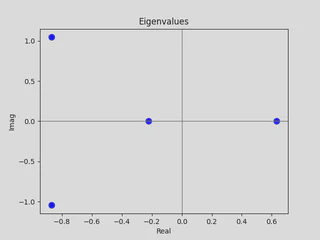 | 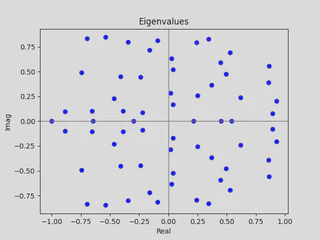 |
|---|---|
| (a) Eigenvalues of a random $4 \times 4$ matrix. | (b) Eigenvalues of a $64 \times 64$ matrix. |
What Are Eigenvalues?
As a refresher (and in case somebody randomly stumbles upon this blog post), let’s recall the object we are studying: eigenvalues.
Definition (Eigenvalue).
\[ A - \lambda I \]
Suppose that $A \in \mathbb{C}^{n \times n}$ is a complex-valued matrix.
An eigenvalue of $A$ is a complex number $\lambda \in \mathbb{C}$ such that the matrixis not invertible.
The spectrum of $A$ is the set of all its eigenvalues, denoted $\sigma(A)$.
This definition is closer to what you would see in a functional analysis class than in an introductory linear algebra course, representing how these ideas generalize to infinite-dimensional settings.
Keeping with the theme of scaling matrices and using the eigenvalue visualizer, we numerically investigate what happens to the spectrum of a random $n \times n$ matrix as $n \to \infty$.
Random Matrices and the Ginibre Ensemble
To make sense of what we mean by a random matrix, let $\mathcal{N}(0,1)$ denote the normal distribution with mean $0$ and variance $1$.
Random matrices we consider will be part of the Ginibre Ensemble.
Definition (Ginibre Ensemble).
The Ginibre ensemble $\mathcal{G}_n$ consists of $n \times n$ matrices $G_n$ with iid entries $g_{ij} \sim \mathcal{N}(0,1)$.
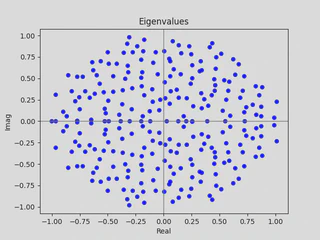 | 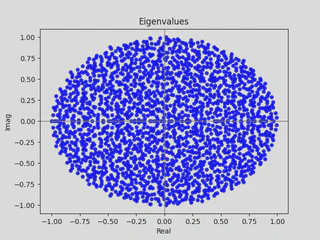 |
|---|---|
| (a) $\sigma(A)$ where $G \in \mathcal{G}_{256}$. | (b) $\sigma(A)$ where $G \in \mathcal{G}_{2048}$. |
This ensemble has many theoretical and practical applications — from modeling atoms with heavy nuclei to network theory.
Scaling and the Limiting Spectrum
Our short numerical investigation considers matrices of the form
$$ A = \frac{1}{\sqrt{n}} G, \quad G \in \mathcal{G}_n. $$The scaling constant $\frac{1}{\sqrt{n}}$ ensures that eigenvalues do not grow infinitely, and that their limiting distribution is not all of $\mathbb{C}$.
Using the eigenvalue visualizer, Figures (a) and (b) above show $\sigma(A)$ for $G \in \mathcal{G}_4$ and $G \in \mathcal{G}_{64}$, respectively.
In both cases, there is no distinguishable pattern, so we need to increase $n$ further.
Eigenvalues for matrices in $\mathcal{G}_{256}$ and $\mathcal{G}_{2048}$ paint a much clearer picture. Here, the limiting distribution appears to be the unit disk $\mathbb{D}$.
Via random matrix theory, one can rigorously show that this is indeed the case — representing stable asymptotic behavior in eigenvalue problems.
Eigenvalue Sensitivity and Matrix Perturbations
Another important aspect of eigenvalues is their sensitivity to matrix perturbations.
Many matrices in applied mathematics, especially those in numerical PDEs, do not take the form of random matrices. Rather, sparse matrices, which have many zero elements, are more useful in this area. With the help of the visualizer, we can show that not all matrix perturbations are created equal — the position of a perturbation can greatly affect its impact on the spectrum of a matrix.
Consider the matrix
$$ A = \begin{pmatrix} 4 & 5 & 0 & 0 \\ 0 & 3 & 0 & 0 \\ 0 & 0 & 2 & 0 \\ 0 & 0 & 0 & 1 \end{pmatrix}. $$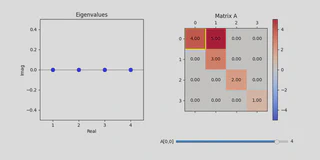 |
|---|
| (a) $A$ and its eigenvalues. |
Graphically, $A$ is shown explicitly to the right of the spectral plot. It has a color map, and there is a slider under $A$.
By changing the slider, you automatically update the spectral plot — which is really neat!
Setting $a_{22} = -5$ (note that we are indexing from 0 in this example), one can see that the spectrum of $A$ does not change.
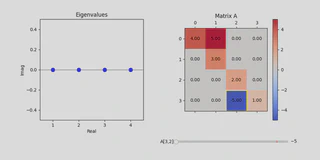 |
|---|
| (b) Perturbing $A$ without changing its eigenvalues. |
This behavior is in stark contrast to changing $a_{10}$.
Setting $a_{01} = -0.12$, which is a small perturbation from 0, one finds that two eigenvalues of $A$ become complex!
This small change drastically alters the matrix’s spectral type.
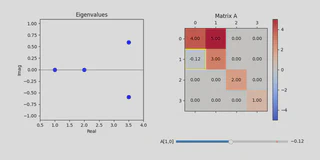 |
|---|
| (c) Perturbing $A$ and drastically changing eigenvalues. |
Closing Thoughts
Playing around with this code is a great way to start thinking about numerical linear algebra. This is a fascinating area, and I hope to cover it more in the future. Eventually, I will include some proofs — but for now, I want to focus on the programs.
You can find the code for this simulation here.